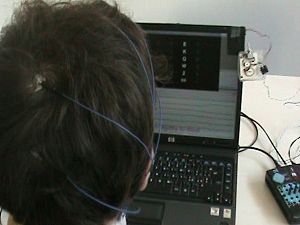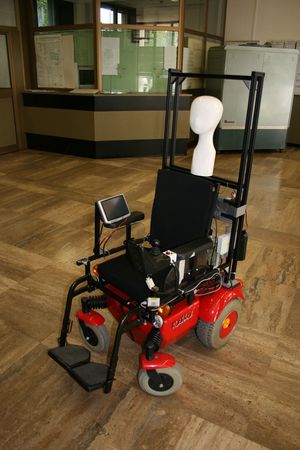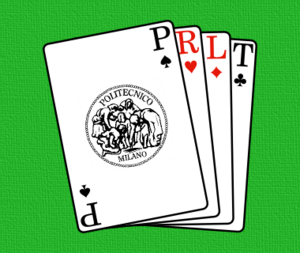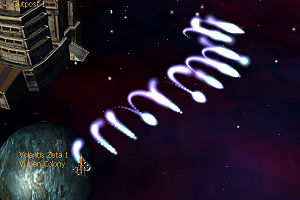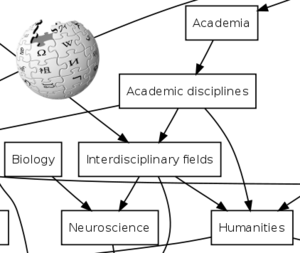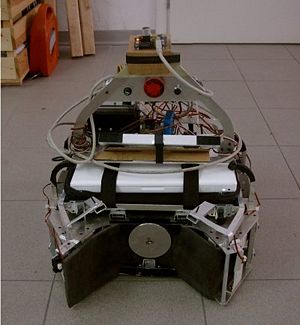Master Level Theses
Here you can find proposals for master thesis (20 CFU for each student). See Project Proposals for other kinds of projects and theses.
Contents
Evolutionary Optimization and Stochastic Optimization
| Title: | Combinatorial optimization based on stochastic relaxation | |
|---|---|---|
| Description: | The project will focus on the study, implementation, comparison and analysis of different algorithms for the optimization of pseudo-Boolean functions, i.e., functions defined over binary variables with values in R. These functions have been studied a lot in the mathematical programming literature, and different algorithms have been proposed [1]. More recently, the same problems have been faced in evolutionary computations, with the use of genetic algorithms, and in particular estimation of distribution algorithms [2,3]. Estimation of distribution algorithms are a recent meta-heuristic, where classical crossover and mutation operators used in genetic algorithms are replaced with operators that comes from statistics, such as sampling and estimation.
The focus will be on the implementation of a new algorithm able to combine different approaches (estimation and sampling, from one side, and exploitation of prior knowledge about the structure of problem, on the other), together with the comparison of the results with existing techniques that historically appear in different (and often separated) communities. Good coding (C/C++) abilities are required. Since the approach will be based on statistical models, the student is supposed to be comfortable with notions that come from probability and statistics courses. The project could require some extra effort in order to build and consolidate some background in math, especially in Bayesian statistics and MCMC techniques, such as Gibbs and Metropolis samplers [4]. The project can be extended to master thesis, according to interesting and novel directions of research that will emerge in the first part of the work. Possible ideas may concern the proposal of new algorithms able to learn existing dependencies among the variables in the function to be optimized, and exploit them in order to increase the probability to converge to the global optimum. Picture taken from http://www.ra.cs.uni-tuebingen.de/
| |
| Tutor: | Matteo Matteucci ([1]), Luigi Malagò (email) | |
| Start: | Anytime | |
| Number of students: | 1-2 | |
| CFU: | 20-40 |
BioSignal Analysis
Analysis of the Olfactory Signal
| Title: | Computational Intelligence techniques to analyse the olfactory signal acquired by an electronic nose for cancer diagnosis | |
|---|---|---|
| Description: | The electronic nose is an instrument able to detect and recognize odors, that is the volatile substances in the atmosphere or emitted by the analyzed substance. This device can react to a gas substance by providing signals that can be analyzed to classify the input. It is composed of a sensor array (MOS sensors, in our case) and a pattern classification system based on machine learning techniques. Each sensor reacts in a different way to the analyzed substance, providing multidimensional data that can be considered as a unique olfactory blueprint of the analyzed substance. We have already tested the use of the electronic nose as diagnostic tool for lung cancer; boosted from the very satisfactory results that we have achieved by these analysis, we want to investigate the possibility of diagnosing other types of cancer and to improve the current computation intelligence techniques.
The project is done in collaboration with the Istituto dei Tumori, Milano.
| |
| Tutor: | Andrea Bonarini (email), Matteo Matteucci (email), Rossella Blatt (email) | |
| Start: | Anytime (a new acquisition phase will start in March) | |
| Number of students: | 1-2 | |
| CFU: | 20 |
Sleep Staging
| Title: | Development of a computer-assisted CAP (Sleep cyclic alternating pattern) scoring method | |
|---|---|---|
| Description: | In 1985, Terzano describes for the first time the Cyclic Alternating Pattern [2] during sleep and, nowadays, CAP is widely accepted by the medical community as basic analysis of sleep. The CAP evaluation is of fundamental importance since it represents the mechanism developed by the brain evolution to monitor the inner and outer world and to assure the survival during sleep. However, visual detection of CAP in polisomnography (i.e., the standard procedure) is a slow and time-consuming process. This limiting factor generates the necessity of new computer-assisted scoring methods for fast CAP evaluation. This thesis deals with the development of a Decision Support System for CAP scoring based on features extraction at multi-system level (by statistical and signal analysis) and Pattern Recognition or Machine Learning approaches. This may allow the automatic detection of CAP sleep and could be integrated, through reinforcement learning techniques, with the corrections given by physicians.
| |
| Tutor: | Matteo Matteucci (email), Martin Mendez (email), Anna Maria Bianchi (email), Mario Terzano (Ospedale di Parma) | |
| Start: | Anytime | |
| Number of students: | 1-2 | |
| CFU: | 20 |
Brain-Computer Interface
| Title: | Recognition of the user's focusing on the stimulation matrix | |
|---|---|---|
| Description: | A P300-based BCI stimulates the user continuously, and the detection of a P300 designates the choice of the user. When the user is not paying attention to the interface, false positives are likely. The objective of this work is to avoid this problem; the analysis of the electroencephalogram (EEG) over the visual cortex (and possibly an analysis of P300s or of other biosignals) should tell when the user is looking at the interface.
| |
| Tutor: | Matteo Matteucci (email), Bernardo Dal Seno (email) | |
| Start: | Anytime | |
| Number of students: | 1-2 | |
| CFU: | 20 |
| Title: | Creation of new EEG training by introduction of noise | |
|---|---|---|
| Description: | A BCI must be trained on the individual user in order to be effective. This training phase require recording data in long sessions, which is time consuming and boring for the user. The aim of this project is to develop algorithm to create new training EEG (electroencephalography) data from existing ones, so as to speed up the training phase.
| |
| Tutor: | Matteo Matteucci (email), Bernardo Dal Seno (email) | |
| Start: | Anytime | |
| Number of students: | 1 | |
| CFU: | 20 |
| Title: | Real-time removal of ocular artifact from EEG | |
|---|---|---|
| Description: | In a BCI based on electroencephalogram (EEG), one of the most important sources of noise is related to ocular movements. Algorithms have been devised to cancel the effect of such artifacts. The project consists in the in the implementation in real time of an existing algorithm (or one newly developed) in order to improve the performance of a BCI.
| |
| Tutor: | Matteo Matteucci (email), Bernardo Dal Seno (email) | |
| Start: | Anytime | |
| Number of students: | 1 | |
| CFU: | 10-20 |
| Title: | Aperiodic visual stimulation in a VEP-based BCI | |
|---|---|---|
| Description: | Visual-evoked potentials (VEPs) are a possible way to drive the a BCI. This projects aims at maximizing the discrimination between different stimuli.
| |
| Tutor: | Matteo Matteucci (email), Bernardo Dal Seno (email) | |
| Start: | Anytime | |
| Number of students: | 1 | |
| CFU: | 20 |
| Title: | Driving an autonomous wheelchair with a P300-based BCI | |
|---|---|---|
| Description: | This project pulls together different Airlab projects with the aim to drive an autonomous wheelchair (LURCH) with a BCI, through the development of key software modules. The work will be validated with live experiments.
| |
| Tutor: | Matteo Matteucci (email), Bernardo Dal Seno (email) | |
| Start: | November 2008 | |
| Number of students: | 1 | |
| CFU: | 5-20 |
Machine Learning
| Title: | Statistical inference for phylogenetic trees | |
|---|---|---|
| Description: | The project will focus on the study, implementation, comparison and analysis of different statistical inference techniques for phylogenetic trees. Phylogenetic trees [1, 2] are evolutionary trees used to represent the relationships between different species with a common ancestor. Typical inference task concern the construction of a tree starting from DNA sequences, involving both the choice of the topology of the tree (i.e., model selection) and the values of the parameters (i.e., model fitting). The focus will be a probabilistic description of the tree, given by the introduction of stochastic variables associated to both internal nodes and leaves of the tree.
The project will focus on the understanding of the problem and on the implementation of different algorithms, so (C/C++ or Matlab or R) coding will be required. Since the approach will be based on statistical models, the student is supposed to be comfortable with notions that come from probability and statistics courses. The project is thought to be extended to master thesis, according to interesting and novel directions of research that will emerge in the first part of the work. Possible ideas may concern the proposal and implementation of new algorithms, based on recent approaches to phylogenetic inference available in the literature, as in [3] and [4]. In this case the thesis requires some extra effort in order to build and consolidate some background in math in oder to understand some recent literature, especially in (mathematical) statistics and, for example, in the emerging field of algebraic statistics [5]. Picture taken from http://www.tolweb.org/tree/
| |
| Tutor: | Matteo Matteucci ([10]), Luigi Malagò (email) | |
| Start: | Anytime | |
| Number of students: | 1-2 | |
| CFU: | 20-40 |
| Title: | Reinforcement Learning in Poker | |
|---|---|---|
| Description: | In this years, Artificial Intelligence research has shifted its attention from fully observable environments such as Chess to more challenging partially observable ones such as Poker.
Up to this moment research in this kind of environments, which can be formalized as Partially Observable Stochastic Games, has been more from a game theoretic point of view, thus focusing on the pursue of optimality and equilibrium, with no attention to payoff maximization, which may be more interesting in many real-world contexts. On the other hand Reinforcement Learning techniques demonstrated to be successful in solving both fully observable problems, single and multi-agent, and single-agent partially observable ones, while lacking application to the partially observable multi-agent framework. This research aims at studying the solution of Partially Observable Stochastic Games, analyzing the possibility to combine the Opponent Modeling concept with the well proven Reinforcement Learning solution techniques to solve problems in this framework, adopting Poker as testbed. | |
| Tutor: | Marcello Restelli (restelli-AT-elet-DOT-polimi-DOT-it) | |
| Start: | Anytime | |
| Number of students: | 1-2 | |
| CFU: | 20-40 |
| Title: | Automatic generation of domain ontologies | [[Image:|center|300px]] |
|---|---|---|
| Description: | This thesis to be developed together with Noustat S.r.l., who are developing research activities directed toward the optimization of knowledge management services, in collaboration with another company operating in this field. This project is aimed at removing the ontology building bottleneck, long and expensive activity that usually requires the direct collaboration of a domain expert. The possibility of automatic building the ontology, starting from a set of textual documents related to a specific domain, is expected to improve the ability to provide the knowledge management service, both by reducing the time-to-application, and by increasing the number of domains that can be covered. For this project, unsupervised learning methods will be applied in sequence, exploiting the topological properties of the ultra-metric spaces that emerge from the taxonomic structure of the concepts present in the texts, and associative methods will extend the concept network to lateral, non-hierarchical relationships. | |
| Tutor: | Matteo Matteucci (email), Andrea Bonarini (email) | |
| Start: | before November 30th | |
| Number of students: | 1-2 | |
| CFU: | 20 |
Computational Intelligence and Games
| Title: | AI in Racing Games | |
|---|---|---|
| Description: | TORCS is a state-of-the-art open source racing simulator that represents an ideal bechmark for machine learning techniques. At the same time, Machine Learning techniques could be used to improve the game experience in this kind of games. Several progect and theses are available on this topic, please contact us for additional information. | |
| Tutor: | Daniele Loiacono (loiacono-AT-elet-DOT-polimi-DOT-it) | |
| Start: | Anytime | |
| Number of students: | 1 to 2 | |
| CFU: | 20 |
| Title: | Automatic Content Generation in Computer Games | |
|---|---|---|
| Description: | The generation of customized game content for each player is an attractive direction to improve the game experience in the next-generation computer games. In this scenario, Machine Learning could play an important role to provide automatically such customized game content. Several progect and theses are available on this topic, please contact us for additional information.
Picutre taken from [11] | |
| Tutor: | Daniele Loiacono (loiacono-AT-elet-DOT-polimi-DOT-it) | |
| Start: | Anytime | |
| Number of students: | 1 to 2 | |
| CFU: | 20 |
| Title: | Human-Like AI in Games | |
|---|---|---|
| Description: | Developing a human-like AI is a challenging and fascinating problem from the point of view of the Artificial Intelligence research. At the same time, it is also a significative prolem for the computer games development: playing against humans is generally more exciting than playing against computers.
Our thesis/projects on this topic involve two different games: Unreal Tournament 2004 and TORCS. | |
| Tutor: | Daniele Loiacono (loiacono-AT-elet-DOT-polimi-DOT-it) | |
| Start: | Anytime | |
| Number of students: | 1 to 2 | |
| CFU: | 20 |
Social Software and Semantic Web
| Wiki Page: | A firefox extension for semantic annotations | |
| Title: | A Firefox extension for semantic annotations | |
| Description: | Aim of this project is to develop a Firefox extension, to allow a community of users to annotate resources on the Web using a shared RDF vocabulary.
While browsing the Web, a user should be able to visualize the annotations relative to the page they are visiting, and to add new annotations as well. | |
| Tutor: | [[DavidLaniado | ]] (, , , , , , , , , , , , , , , , , , … further resultswarning.png
| |
| Start: | ||
| Students: | 1 - 2 | |
| CFU: | 5 - 20 | |
| Research Area: | Social Software and Semantic Web | |
| Research Topic: | Semantic Annotations |
| Wiki Page: | Annotation aggregators from social applications | |
| Title: | Annotation aggregators from social applications | |
| Description: | Annotations are metadata published about a resource, such as tags in del.icio.us, comments on stumbleupon.com, or twines on Twine.com. One of the main problems of these annotations is that they are not expressed in a standard format: thus, any tool trying to aggregate information from these sources should be able to access each one of them in a different way.
The purpose of this project is to develop translation tools for different social annotation systems, collect their data in a common format (expressed using an ontology), and show them through a unique user interface, able to display different annotations (i.e. geo coordinates, dates, tags, etc.) in different ways. Moreover, tests and evaluations should be performed on this aggregator to show how efficient the queries are when performed on-the-fly or from an intermediate knowledge base. | |
| Tutor: | [[DavideEynard | ]] (, , , , , , , , , , , , , , , , , , … further resultswarning.png
| |
| Start: | ||
| Students: | 1 - 2 | |
| CFU: | 5 - 20 | |
| Research Area: | Social Software and Semantic Web | |
| Research Topic: | Semantic Annotations |
| Wiki Page: | Detecting patterns in ontology usage | |
| Title: | Detecting patterns in ontology usage | |
| Description: | When building a new knowledge base the reuse of existing, well known vocabularies is often desirable. However, sometimes it is not clear which ontology should be preferable or which term is best suited for a specific application. Aim of this project is to detect patterns in ontology usage by harvesting ontologies which use a given schema (i.e. Foaf or Dublin Core) and analysing how people are using them in practice. The resulting application should download ontologies from the main semantic search engines (such as http://watson.kmi.open.ac.uk/ and http://sindice.com/), parse them and calculate statistics about the terms used inside them. The tool should show these statistics, save them in an appropriate format and make them available through an API for use by external applications. | |
| Tutor: | [[DavideEynard | ]] (, , , , , , , , , , , , , , , , , , … further resultswarning.png
| |
| Start: | ||
| Students: | 1 - 2 | |
| CFU: | 5 - 20 | |
| Research Area: | Social Software and Semantic Web | |
| Research Topic: | Semantic Annotations |
| Wiki Page: | Extending a search engine with semantic information | |
| Title: | Extending a search engine with semantic information | |
| Description: | We are used to keyword-based search engines, where only documents matching the exact words in the query are retrieved. In a traditional search engine, if you submit the query "a dinosaur in a university in Lombardy" you won't probably find a document containing the phrase "a velociraptor in Politecnico di Milano", even though it's more or less what you were looking for.
Aim of this project is to expand a traditional search engine with semantic information, so that also documents containing words related to the ones in the query can be retrieved. Existing thesauri and ontologies can be used, as well as more dynamic and collaborative sources of knowledge such as user tags and wikipedia pages and categories. Starting points for this work can be the projects "SeQuEx - Semantic Query Expansion" and "Enriching search results with semantic metadata". | |
| Tutor: | [[DavidLaniado | ]] (, , , , , , , , , , , , , , , , , , … further resultswarning.png
| |
| Start: | ||
| Students: | 1 - 2 | |
| CFU: | 5 - 20 | |
| Research Area: | Social Software and Semantic Web | |
| Research Topic: | Semantic Search |
| Wiki Page: | Mining wikipedia categories | |
| Title: | Wikipedia category map | |
| Description: | Wikipedia articles are organized in a hierarchy of categories, manually assigned by users. This process can be considered a huge effort for the collective categorization of human knowledge; the result is a wide and disordered graph which can provide precious information for a variety of applications (natural language processing, information retrieval, ontology building...).
In the project "Wikipedia Category Map" a tool has been developed to extract the graph of Wikipedia categories, to store it in RDF format and to interactively visualize and explore it. Aim of this project is to analyze the resulting graph for the extraction of semantic relationships; for example it is possible to define metrics of distance between topics in the graph, which can be useful for various purposes in information retrieval. | |
| Tutor: | [[DavidLaniado | ]] (, , , , , , , , , , , , , , , , , , … further resultswarning.png
| |
| Start: | 7 July 2009 | |
| Students: | 1 - 2 | |
| CFU: | 5 - 20 | |
| Research Area: | Social Software and Semantic Web | |
| Research Topic: | Semantic Tagging |
| Wiki Page: | Social Network Data Extraction from Online Communities | |
| Title: | Social Network Data Extraction From Online Communities | |
| Description: | With the growth of the Web and the emergence of online communities, a huge amount of data regarding social relationships is now available, that was unthinkable until a few years ago. The network of connections may unveil precious information about communities structures and dynamics and the spreading of information in the Web.
Aim of this project is to design and develop a software tool to extract this kind of information from a single social network platform (decided by the student). It may be required also some kind of analysis or visual representation of the collected data. | |
| Tutor: | [[DavidLaniado | ]] (, , , , , , , , , , , , , , , , , , … further resultswarning.png
| |
| Start: | ||
| Students: | 1 - 2 | |
| CFU: | 5 - 20 | |
| Research Area: | Social Software and Semantic Web | |
| Research Topic: | Social Network Analysis |
| Wiki Page: | Use case design and implementation for semantic annotations | |
| Title: | Use case design and implementation for semantic annotation | |
| Description: | Semantic annotations offer a variety of possibilities to enhance the user experience while browsing the Web. Aim of this project is to propose one scenario in which their usefulness is exploited for a specific community of users. In detail the project requires to design a simple ontology which describes some kind of domain to annotate resources on the Web and implement an interface to query it and insert assertions inside a semantic store (through SPARQL).
One possible example is the annotation of mp3 files available on the Web. They can be classified in genres or associated to datatype properties, such as rating, title, length and release date... also exploiting data already available in http://musicbrainz.org/ | |
| Tutor: | [[DavideEynard | ]] (, , , , , , , , , , , , , , , , , , … further resultswarning.png
| |
| Start: | ||
| Students: | 1 - 2 | |
| CFU: | 5 - 10 | |
| Research Area: | Social Software and Semantic Web | |
| Research Topic: | Semantic Annotations |
| Wiki Page: | Wikipedia Page Social Network | |
| Title: | Wikipedia Page Social Network | |
| Description: | Goal of this project is to study the social network of Wikipedia pages, where two pages are connected if they share at least one main contributor. This social network can be studied to reveal interesting information; for example, it is possible to extract clusters of pages which apparently have nothing in common. A metric of distance between pages in the network can be defined, and compared with other metrics, such as the distance in the category tree or in the hyperlink graph. | |
| Tutor: | [[DavidLaniado | ]] (, , , , , , , , , , , , , , , , , , … further resultswarning.png
| |
| Start: | ||
| Students: | 1 - 2 | |
| CFU: | 5 - 20 | |
| Research Area: | Social Software and Semantic Web | |
| Research Topic: | Social Network Analysis |
| Wiki Page: | Wikipedia Tripartite Graph | |
| Title: | Wikipedia Tripartite Graph | |
| Description: | When a user edits a Wikipedia page, we can establish a link among her, the page and the categories to which the page belongs. A model to represent this information is a tripartite graph. Aim of this project is to build a tripartite graph from Wikipedia users, pages and categories, and mine the outcome network to extract emergent semantics. | |
| Tutor: | [[DavidLaniado | ]] (, , , , , , , , , , , , , , , , , , … further resultswarning.png
| |
| Start: | ||
| Students: | 1 - 2 | |
| CFU: | 20 - 20 | |
| Research Area: | Social Software and Semantic Web | |
| Research Topic: | Social Network Analysis, Semantic Tagging |
Robotics
| Title: | Robot games | |
|---|---|---|
| Description: | The goal of this activity is to develop an interactive game with robots using commercial devices such as the WII Mote (see the Robogames page)
Projects are available in different areas:
These projects allow to experiment with real mobile robots and real interaction devices. Parts of these projects can be considered as course projects. These projects can also be extended to cover course projects. | |
| Tutor: | Andrea Bonarini (bonarini-AT-elet-DOT-polimi-DOT-it) | |
| Start: | Anytime | |
| Number of students: | 1-2 | |
| CFU: | 7.5-20 |


